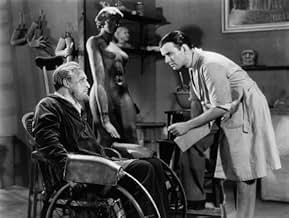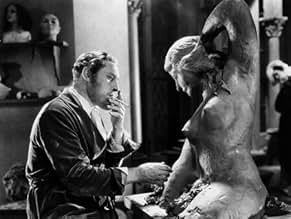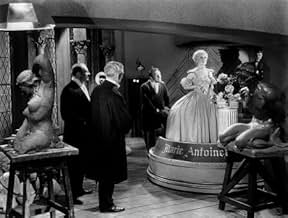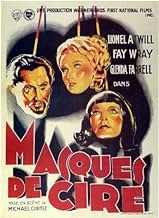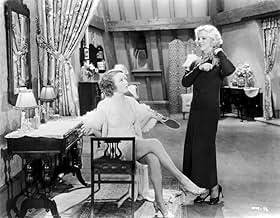Das Geheimnis des Wachsfigurenkabinetts
Originaltitel: Mystery of the Wax Museum
IMDb-BEWERTUNG
6,8/10
7228
IHRE BEWERTUNG
Füge eine Handlung in deiner Sprache hinzuThe disappearance of people and corpses leads a reporter to a wax museum and a sinister sculptor.The disappearance of people and corpses leads a reporter to a wax museum and a sinister sculptor.The disappearance of people and corpses leads a reporter to a wax museum and a sinister sculptor.
- Regie
- Drehbuch
- Hauptbesetzung
Thomas E. Jackson
- Detective
- (as Thomas Jackson)
Bull Anderson
- Janitor
- (Nicht genannt)
Frank Austin
- Winton's Valet
- (Nicht genannt)
Max Barwyn
- Museum Visitor
- (Nicht genannt)
Wade Boteler
- Ambrose
- (Nicht genannt)
Empfohlene Bewertungen
These days, Mystery of the Wax Museum has become best known for the fact that it was the film that spawned the 1953 classic starring Vincent Price. This is somewhat unfair, however, as although this film isn't a brilliant masterpiece, or even genre classic, it has a right to remembered in it's own right. The film is actually quite daring and inventive for the time when it was made; and despite the fact that nothing too bad is graphically shown, for obvious reasons, some of the imagery on display does actually succeed in being quite disturbing. Take the deformed face of the central character for example; it won't keep you up all night, but considering the time when this was made; the effects are good. The two-strip Technicolor style of the film gives it something of a unique feel; and this again is to it's credit as the film has aged really, really well. The plot line will be familiar to anyone who has seen the Vincent Price version, but here, aside from a museum proprietor that gets his life work melted away in an inferno; we've got a press investigation into the affairs as well.
Lionel Atwill takes the lead role as the unfortunate victim of the flames, and while he's certainly no Vincent Price; he does well with what he's got and helps to create a macabre surrounding around his character, which in turn helps the film in the atmosphere department. Joining him are Glenda Farrell and Fay Wray as the heroine's of the story. Wray plays the girl that the unfortunate artist becomes obsessed with, and Farrell gives a slightly irritating, but very lively performance as a journalist. Both do well with their roles, and although this film isn't exactly an exhibition in acting (unlike Curtiz's masterpiece, Casablanca); the cast do well enough. One thing that is unfortunate for this film is that it's seen as a second feature for the Price version, which will harm what some viewers think of it as the plot elements are very similar to the 1953 film, so it can, at times, feel as though you're simply watching the same film again. However, if viewed as a stand-alone product, Mystery of the Wax Museum represents a solid 30's horror movie and I can see why any horror fan wouldn't enjoy it.
Lionel Atwill takes the lead role as the unfortunate victim of the flames, and while he's certainly no Vincent Price; he does well with what he's got and helps to create a macabre surrounding around his character, which in turn helps the film in the atmosphere department. Joining him are Glenda Farrell and Fay Wray as the heroine's of the story. Wray plays the girl that the unfortunate artist becomes obsessed with, and Farrell gives a slightly irritating, but very lively performance as a journalist. Both do well with their roles, and although this film isn't exactly an exhibition in acting (unlike Curtiz's masterpiece, Casablanca); the cast do well enough. One thing that is unfortunate for this film is that it's seen as a second feature for the Price version, which will harm what some viewers think of it as the plot elements are very similar to the 1953 film, so it can, at times, feel as though you're simply watching the same film again. However, if viewed as a stand-alone product, Mystery of the Wax Museum represents a solid 30's horror movie and I can see why any horror fan wouldn't enjoy it.
In the early 30s, Hungarian director Michael Curtiz was still considered a recently arrived foreigner working at Warner Bros. after impressing legendary producer Jack Warner with his work in Germany. In those early days of his career in the U.S. Curtiz began to make himself a name as a hard working director who always managed to work effectively under the studio system, and it was with the success of the horror films, "The Mad Genius" and "Doctor X", when he proved to be not only effective, but also able to make box-office hits. It was really the success of "Doctor X" what prompted Warner Brothers to make another horror movie in the same style, with the same same cast, and keeping Michael Curtiz as director. The result was the now classic Technicolor thriller, "Mystery of the Wax Museum".
Ivan Igor (Lionel Atwill) is an extremely talented sculptor of wax figures in London, however, his employer thinks that Igor's business i snot making enough money for both of them, and starts a fire at Igor's Wax Museum in order to collect the insurance money. Thirteen years later, Ivan Igor is tragically crippled and unable to use his hands, but with the help of his students he is finally ready to reopen his museum in New York City. In the meantime, the police is baffled by the case of several corpses stolen from the City's morgue, including the one of a famous socialité. The case attracts the attention of Florence Dempsey (Glenda Farrell), a young reporter looking for her big story, and immediately she starts to investigate. Her suspicion will lead her to important clues, and Igor's strange obsession with Florence's roommate Charlotte (Fay Wray) will take her to uncover the strange mystery of the Wax Museum.
The key word in "Mystery of the Wax Museum" is "Mystery", as unlike it's better known 1953 remake (which focuses on horror and suspense), this version of Charles Belden's play behaves more like a simple, yet really captivating, tale of mystery where our main character, Florence, must discover who and more importantly "how" is committing the crimes. Adapted by Don Mullaly and Carl Erickson, the movie has a very original plot that unfolds nicely despite the fast pace of the film. The fact that it was written before the days of the Hays code allows the film to include lots of sexual innuendo and situations that later would be considered immoral. The characters are overall very well developed, and the addition of comedy (courtesy of Farrell's wisecracking character) works nicely with the creepy mystery of the story.
On of the lasts movies to be shot in the primitive two-color Technicolor system, it has a marvelous bleached look that works perfectly with the modernist art-deco style of the sets designed for the film. Director Michael Curtiz allows himself to show the influence he received when working in Germany during the years of expressionism, and gives the film an ominous dark look as Florence gets deeper inside the Wax Museum (although not as striking as what Universal Studios did with its horror films). It's worth to point out that while Curtiz may be better known as an effective director for hire under the studio system, he really shows a definite style in this film, and begins to give form to the elements that would later become part of his masterpiece, "Casablanca".
The cast is overall excellent, although it is of course difficult not to make comparisons with the performances of the better known 50s version. Lionel Atwill offers one of his most underrated performances of his career as Ivan Igor, and while he lacks the charm that Vincent Price would give to the role, he is very believable as the tortured artist, victim of misfortune. Glenda Farrell's turn as Florence Dempsey has been harshly criticized due to the comic nature of her character's persona, but honestly she makes a terrific job as the main character, vastly overshadowing the more famous Fay Wray; who while looking stunningly beautiful here, lacks the presence that would make her an icon in "King Kong".
While "House of Wax" tends to get the upper hand when compared to the original version, "Mystery" is by no means a bad movie, simply a different one. As written above, this movie focuses completely on the mystery aspect of the story, and while it does have its fair share of horrific elements, they are minimal when compared with the Gothic horror of "House of Wax". True, it certainly looks dated by today's standards, but the movie has a notorious modernist (in the architecture, designs, etc...) touch that may have looked futurist for the 30s society. The special effects are definitely less impressive than in the remake, but considering the times when they were done are still an excellent work, and some look really impressive thanks to the lavish Technicolor process.
Personally, I find in "House" and "Mystery" a classic example of what a remake should be, as the two are excellent movies that explore the same story under different angles. Fans tend to dismiss "Mystery", but I think it's equally as good as the legendary Vincent Price film. "Mystery of the Wax Museum" is a very interesting movie for fans of "House of Wax", and a definitive must-see for those interested in horror movies of the 30s. 8/10
Ivan Igor (Lionel Atwill) is an extremely talented sculptor of wax figures in London, however, his employer thinks that Igor's business i snot making enough money for both of them, and starts a fire at Igor's Wax Museum in order to collect the insurance money. Thirteen years later, Ivan Igor is tragically crippled and unable to use his hands, but with the help of his students he is finally ready to reopen his museum in New York City. In the meantime, the police is baffled by the case of several corpses stolen from the City's morgue, including the one of a famous socialité. The case attracts the attention of Florence Dempsey (Glenda Farrell), a young reporter looking for her big story, and immediately she starts to investigate. Her suspicion will lead her to important clues, and Igor's strange obsession with Florence's roommate Charlotte (Fay Wray) will take her to uncover the strange mystery of the Wax Museum.
The key word in "Mystery of the Wax Museum" is "Mystery", as unlike it's better known 1953 remake (which focuses on horror and suspense), this version of Charles Belden's play behaves more like a simple, yet really captivating, tale of mystery where our main character, Florence, must discover who and more importantly "how" is committing the crimes. Adapted by Don Mullaly and Carl Erickson, the movie has a very original plot that unfolds nicely despite the fast pace of the film. The fact that it was written before the days of the Hays code allows the film to include lots of sexual innuendo and situations that later would be considered immoral. The characters are overall very well developed, and the addition of comedy (courtesy of Farrell's wisecracking character) works nicely with the creepy mystery of the story.
On of the lasts movies to be shot in the primitive two-color Technicolor system, it has a marvelous bleached look that works perfectly with the modernist art-deco style of the sets designed for the film. Director Michael Curtiz allows himself to show the influence he received when working in Germany during the years of expressionism, and gives the film an ominous dark look as Florence gets deeper inside the Wax Museum (although not as striking as what Universal Studios did with its horror films). It's worth to point out that while Curtiz may be better known as an effective director for hire under the studio system, he really shows a definite style in this film, and begins to give form to the elements that would later become part of his masterpiece, "Casablanca".
The cast is overall excellent, although it is of course difficult not to make comparisons with the performances of the better known 50s version. Lionel Atwill offers one of his most underrated performances of his career as Ivan Igor, and while he lacks the charm that Vincent Price would give to the role, he is very believable as the tortured artist, victim of misfortune. Glenda Farrell's turn as Florence Dempsey has been harshly criticized due to the comic nature of her character's persona, but honestly she makes a terrific job as the main character, vastly overshadowing the more famous Fay Wray; who while looking stunningly beautiful here, lacks the presence that would make her an icon in "King Kong".
While "House of Wax" tends to get the upper hand when compared to the original version, "Mystery" is by no means a bad movie, simply a different one. As written above, this movie focuses completely on the mystery aspect of the story, and while it does have its fair share of horrific elements, they are minimal when compared with the Gothic horror of "House of Wax". True, it certainly looks dated by today's standards, but the movie has a notorious modernist (in the architecture, designs, etc...) touch that may have looked futurist for the 30s society. The special effects are definitely less impressive than in the remake, but considering the times when they were done are still an excellent work, and some look really impressive thanks to the lavish Technicolor process.
Personally, I find in "House" and "Mystery" a classic example of what a remake should be, as the two are excellent movies that explore the same story under different angles. Fans tend to dismiss "Mystery", but I think it's equally as good as the legendary Vincent Price film. "Mystery of the Wax Museum" is a very interesting movie for fans of "House of Wax", and a definitive must-see for those interested in horror movies of the 30s. 8/10
In the early 1930's Jack Warner was under contract to use the Two-strip technicolor process on a Warner Brothers film. Unfortunately, this primitive form of color cinematography had a limited pallet of colors. Everything had an unnatural pastel look. Warner wisely choose a genre not dependent on reality- the horror film. Their first color horror film was DOCTOR X, a wild and macabre who-dunnit complete with scary murders, truly mad doctors and a cannibal. DOCTOR X, released in 1932, was enough of a success, that Warner Brothers reunited it's director, Michael Curtiz, the two leads, Lionel Atwill and Fay Wray, and the two strip Technicolor process for yet another horror film. The new film, simply titled WAX MUSEUM during production was a fast moving creepy chiller that mixed the gloom of Depression era New York with the creepy going-ons of a wax museum. The film begins in 1921. Sculptor Ivan Igor (a bohemian looking Lionel Atwill), so obsessed creating his wax museum, that he ignores that he and his partner, Worth (Edwin Maxwell) are in deep financial trouble. Worth sets fire to the museum to collect on a fire insurance policy. The museum is destroyed, and Igor is left a cripple with useless hands.
Twelve years later, in Manhattan, Igor opens a new wax museum. At the same time, a wisecracking reporter, Florence (Glenda Farrell) tracks a hot case of the corpse of a recently murdered socialite stolen from the morgue. She begins to suspect that creepy wax museum downtown of stealing bodies and posing them as wax statues. What makes things worse, is that her best friend, Ruth (Fay Wray) is dating the most innocent of the questionable wax-workers. THE MYSTERY OF THE WAX MUSEUM is a DVD shelf must-have.
Twelve years later, in Manhattan, Igor opens a new wax museum. At the same time, a wisecracking reporter, Florence (Glenda Farrell) tracks a hot case of the corpse of a recently murdered socialite stolen from the morgue. She begins to suspect that creepy wax museum downtown of stealing bodies and posing them as wax statues. What makes things worse, is that her best friend, Ruth (Fay Wray) is dating the most innocent of the questionable wax-workers. THE MYSTERY OF THE WAX MUSEUM is a DVD shelf must-have.
She has been so sorely maligned. Despite what has been claimed by others here, Glenda Farrell was not a bad actress. A little broad sometimes perhaps, but not bad. She is a dynamo of live energy, which the film badly needs, for the only other energetic character in the film is Atwill, and only Farrell has the force to bring him down(that the script does not let her do so personally betrays the character). It is not Farrell's performance or even her character which is the problem of the film, but the script which makes that character necessary. Chock Full O' undeveloped characters (only Atwill and Farrell qualify as more than ciphers)whose paths cross coincidentally,Farrell's reporter is the one in the middle bringing the disparate elements together. A reporter or policeman had to be the central character, for only one of those two would be privy to all or even enough of the info needed to solve the puzzle, or to even recognize that the puzzle existed. And only a female reporter could be Fay Wray's roommate, as female police detectives or beat cops didn't exist(at least not in Hollywood). And only a fast-talking, wisecracking, brash and fierce female reporter able to beat the stereotypical fast-talking, wisecracking, brash 1930's male reporter at his own game could find the story AND crack the case before the police. Others have objected to the attention given the comic relief, apparently misunderstanding the term. Comic relief characters are supporting characters, and in this film, despite third billing, Glenda Farrell is the female lead. Fay Wray was a freelancer and able to negotiate better billing even though her role doesn't deserve it. Had she not had a real lead in the companion film DR.X, it's unlikely she would have been asked to take such a small part. Charlotte is needed in the story only for a face, and her face and scream are all Wray is allowed to bring to the role. As outstanding as those two attributes are, they don't add up to a real character. And while Farrell cracks wise, she is doing serious work central to the tale. A role with comedic content is not automatically a comic relief part. The script is a mess, letting down the great concept. HOUSE OF WAX is a much tighter script, more linear, combining ingenue and snoop into one role, and beefing up the part of the disfigured sculptor. It drops the very extraneous playboy character and the loose ends which trail in his wake. But most agree that HOUSE is boring compared to MYSTERY, and in addition to the direction and editing, much of MYSTERY's drive comes from the girl reporter and the crack actress who played her. Even if you do find her grating, Glenda Farrell is never boring.
This film, which was remade as "House Of Wax" 20 years later (as if you didn't know), might not enjoy quite the reputation it does today had it not been the basis for the better-known later film and, more importantly, believed lost for over 30 years, which made it something of a legend for many people who'd never even seen it. Legendary status can be rather difficult to live up to, and unless a viewer is approaching it with no advance knowledge of its history, MYSTERY OF THE WAX MUSEUM may not be quite what one expects.
It is, nevertheless, an energetic and entertaining amalgam of genres: horror film meets newspaper crime drama. Dropping a rather Gothic tale of body-snatching, a mad sculptor and a museum of wax-covered corpses into the streamline-moderne milieu of fast-talking, wise-cracking reporters on the trail of a hot story makes for interesting contrasts.
Lionel Atwill, as Ivan Igor, the artist driven to insanity and murder by the destruction of his wax "children" in an arson fire, was an immensely enjoyable performer whose best work came a bit later (see "Son Of Frankenstein" for his portrayal of the one-armed Insp. Krogh). His natural screen presence carries him through, though he never quite generates either the pathos or the smooth menace that Vincent Price displayed in the remake. But from the moment of her entrance, it's Glenda Farrell as Florence Dempsey, the reporter out to save her job by bringing in a scoop - barreling onto the screen with a full head of steam - who propels the story all the way to its finish.
There's an awful lot going on here beyond the basic premise; bootlegging, a "dope fiend," a suicide and a falsely implicated millionaire playboy are thrown into the mix, packing quite a lot into the 77 minute running time (the remake improved the story by eliminating extraneous characters and subplots). A pre-"King Kong" Fay Wray (in her naturally red hair sans the "Kong" blond wig) is the damsel in actual distress, but despite her billing, she's basically a supporting player and has little to do - beyond enduring roommate Florence's snide comments about her penniless boyfriend - until the climactic confrontation between all the bad guys and good guys (and girls).
MYSTERY is well-served by the direction of Michael Curtiz ("Adventures Of Robin Hood," "Casablanca"), who was something of a jack-of-all-genres, and there's plenty of snappy dialogue, some of which (Florence asking a cop, "How's your sex life?") wouldn't have made it to the screen a year later under the newly re-written Production Code. Depending on one's point of view, it could be said that the very effective production design either benefits, or suffers, from the pale pastels of the two-strip Technicolor photography. For my part, I'm guessing that the subdued tones we see today result from the lack of first-rate film elements available. Having seen far superior two-strip from years earlier, I'll wager that the original prints were much more vivid.
If you're any kind of a fan of the remake, you do owe it to yourself to see this one, if only once. There are many things to enjoy in MYSTERY OF THE WAX MUSEUM, not the least of which are the fabulous ensembles worn by Farrell. Just how does a newspaper reporter one step away from the breadline afford a wardrobe like that?
It is, nevertheless, an energetic and entertaining amalgam of genres: horror film meets newspaper crime drama. Dropping a rather Gothic tale of body-snatching, a mad sculptor and a museum of wax-covered corpses into the streamline-moderne milieu of fast-talking, wise-cracking reporters on the trail of a hot story makes for interesting contrasts.
Lionel Atwill, as Ivan Igor, the artist driven to insanity and murder by the destruction of his wax "children" in an arson fire, was an immensely enjoyable performer whose best work came a bit later (see "Son Of Frankenstein" for his portrayal of the one-armed Insp. Krogh). His natural screen presence carries him through, though he never quite generates either the pathos or the smooth menace that Vincent Price displayed in the remake. But from the moment of her entrance, it's Glenda Farrell as Florence Dempsey, the reporter out to save her job by bringing in a scoop - barreling onto the screen with a full head of steam - who propels the story all the way to its finish.
There's an awful lot going on here beyond the basic premise; bootlegging, a "dope fiend," a suicide and a falsely implicated millionaire playboy are thrown into the mix, packing quite a lot into the 77 minute running time (the remake improved the story by eliminating extraneous characters and subplots). A pre-"King Kong" Fay Wray (in her naturally red hair sans the "Kong" blond wig) is the damsel in actual distress, but despite her billing, she's basically a supporting player and has little to do - beyond enduring roommate Florence's snide comments about her penniless boyfriend - until the climactic confrontation between all the bad guys and good guys (and girls).
MYSTERY is well-served by the direction of Michael Curtiz ("Adventures Of Robin Hood," "Casablanca"), who was something of a jack-of-all-genres, and there's plenty of snappy dialogue, some of which (Florence asking a cop, "How's your sex life?") wouldn't have made it to the screen a year later under the newly re-written Production Code. Depending on one's point of view, it could be said that the very effective production design either benefits, or suffers, from the pale pastels of the two-strip Technicolor photography. For my part, I'm guessing that the subdued tones we see today result from the lack of first-rate film elements available. Having seen far superior two-strip from years earlier, I'll wager that the original prints were much more vivid.
If you're any kind of a fan of the remake, you do owe it to yourself to see this one, if only once. There are many things to enjoy in MYSTERY OF THE WAX MUSEUM, not the least of which are the fabulous ensembles worn by Farrell. Just how does a newspaper reporter one step away from the breadline afford a wardrobe like that?
Wusstest du schon
- WissenswertesThis film was produced before the Production Code. When it was remade 20 years later, as Das Kabinett des Professor Bondi (1953), all references to drug use were removed, and a character was changed from a junkie to an alcoholic.
- PatzerIvan Igor says that Jean Paul Marat's assassin, Charlotte Corday, was his mistress. This is incorrect; they never had met until she came to his office posing as a courier and quickly stabbed him to death. After her execution a few days later, she was found to be virgo intacta.
- Alternative VersionenThis film was shot in two versions. One camera unit shot the film in two-color Technicolor. A second camera unit shot the scenes at the same time in black and white. The black and white version was meant for theaters who could not afford the higher rental cost of the color prints.
- VerbindungenEdited into Mame (1974)
Top-Auswahl
Melde dich zum Bewerten an und greife auf die Watchlist für personalisierte Empfehlungen zu.
Details
- Erscheinungsdatum
- Herkunftsland
- Sprache
- Auch bekannt als
- Mystery of the Wax Museum
- Drehorte
- Produktionsfirma
- Weitere beteiligte Unternehmen bei IMDbPro anzeigen
- Laufzeit1 Stunde 17 Minuten
- Seitenverhältnis
- 1.37 : 1
Zu dieser Seite beitragen
Bearbeitung vorschlagen oder fehlenden Inhalt hinzufügen

Oberste Lücke
By what name was Das Geheimnis des Wachsfigurenkabinetts (1933) officially released in India in English?
Antwort

